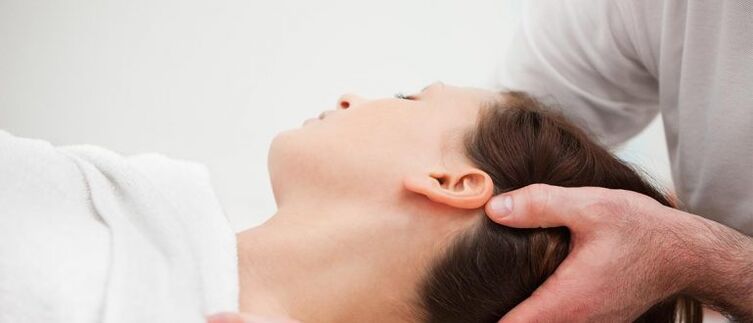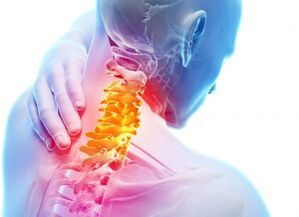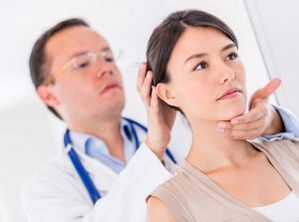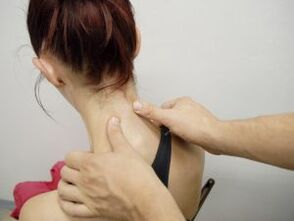Osteocartilage emitted by the cervical spine (shopping) can cause many unsafe complications, the most difficult of which are disability and persistent deterioration.Therefore, don't ignore the signs of illness and see a doctor immediately.Only timely treatment will help avoid unpleasant consequences.

Cervical osteochondrosis is a very unpleasant disease that can suffer from disorders even the brain.
Reasons for development
Pathology usually occurs in old age, but this does not mean that older people will suffer from cervical bone cartilage.According to observations, the main causes of the disease are:
- A sedentary lifestyle;
- an improperly organized workplace;
- Too much weight;
- pressure, over-construction of tension;
- Autoimmune diseases, dystrophy in muscles occurs.
- Congenital pathology of the spine;
- Often hypothermia.
Characteristic Symptoms
Dizziness
The manifestation of this symptom of cervical osteochondrosis is not clear, but depending on the nature of the country, one can determine what the sign of violation is.Distinguish dizziness:
- Systematic.When it appears that the surrounding objects move (symptoms of osteochondrosis).
- Non-systemic.There is no feeling of circulating exercise, but the symptoms of fuss, darkening of the eyes, nausea (cardiovascular pathology) expression.
With the development of cervical osteochondrosis, dizziness is a result:
- spasm of the veins and arteries in the middle cerebral;
- pushes blood vessels in the cervical area;
- Vestibular dysfunction.

Headache
Symptoms are often observed in women with C6-C7 disc herniation.Pathology is pronounced in nature or disturbed regularly.In this case, it is not possible to independently determine the cause of the pain in this case, so it is important to rule out arterial hypertension, angina, cardiovascular failure, stroke, stroke, and make a diagnostic test and make an accurate diagnosis from a doctor.
Discomfort in other parts of the body
Osteocartilage of the cervical spine that exhibits pain in different places, while the symptoms may be sharp or moderate.
Worry about pain in each part of the neck, shoulders and upper limbs.Muscle spasms occur basically in the morning and gradually pass through during physical exercise.Typical feelings of disease:
- shooting and dull pain in the neck;
- Neck turns and crackle;
- Muscle weakness, numbness, and chicken skin ump is particularly obvious because of the herniation of the C4-C6 disc.

blood pressure
Because osteocartilage degeneration of the cervical spine often involves blood pressure as the patient removes it, the vertebrae of the neck penetrates many nerve fibers, hematologic arteries and blood vessels.Due to their compression, violations of blood circulation occur due to increased or decreased pressure.The symptoms are as follows:
- migraine;
- The feeling of heavy chest, unable to breathe completely;
- Numbness in the neck;
- Stress, physical exercise, long-term stay in an uncomfortable position, the well deteriorates.
Degree of development
Phase 1
Cervical osteochondrosis at this stage begins with pathological changes in the intervertebral disc, which loses elasticity, strength, dryness and decreases in size.The fibrous ring is covered with cracks.Due to damage to the cervix section 1 of the stage, the condition is still satisfactory because the symptoms are not particularly troublesome, but in the morning, the neck is painful.
Level 2
If signs of cervical vertebrae are ignored and the patient refuses to treat the patient, a 2-degree publicity is observed, with rapid development of pathological symptoms.The intervertebral disc is gradually destroyed, and the cervical vertebrae is small dislocation.2 The period of this disease is characterized by the development of "head" syndrome, where there is obvious pain and discomfort and the patient needs to keep his head in a fixed position, thus promoting a good condition.

Level 3
Osteochondrosis in the cervical area is manifested in obvious symptoms.Due to these diseases, the herniation of the intervertebral disc or hernia, the patient's voice, the man in the man has a lump in his throat, so it is difficult for a person to swallow.In addition, the pathology is characterized by:
- Expressing headaches;
- Dizziness and nausea;
- A bastard with cervical straps;
- The development of complications, which is called cervical marrow disease.
Fourth degree
In the final stage, the disc is completely destroyed and connective tissue is formed in its position.One person has:
- Violation of vestibular equipment;
- migraine and dizziness;
- Noise in the ears;
- Visual violation.
Pathological syndrome
There are complexes with such symptoms:

- heart.In terms of performance, it is similar to the pathology of the cardiovascular system.Patients complain about this sign:
- burning in the chest;
- Shortness of breath;
- deterioration of general wells;
- Angina pectoris.
- Spine.If signs of this syndrome are involved, it means that the bones and cartilage tissue in the neck are damaged.Pathological changes in the vertebrae and intervertebral disc are clearly seen in the X-ray pictures.One person is worried:
- Neck mobility issues;
- Discomfort when moving.
- Driven arterial syndrome.In this case, pathology affects veins and arteries in the cervical area and provides the necessary substances to the brain.Due to the transmission of blood vessels, there is insufficient blood supply to gray matter.Patients are worried:
- powerful migraine;
- partial vision and hearing;
- Bench hell;
- drowsiness;
- Dizziness;
- Frustrated;
- Deterioration of concentration.
- Koreshka.Due to this violation, one of the 8 pairs of roots was affected, and one side was mainly observed in the human body.Due to this syndrome, severe pain is involved or paralyzed when sensitivity is completely lost.
result
If you do not start timely treatment for cervical osteochondrosis, there is a risk of this complication:
- VSD and constant pressure surge;
- Violation of vestibular equipment;
- Thyroid pathology;
- Hypertension or hypotension;
- Stroke.

diagnosis
The neurologist who needs to visit first will help diagnose osteochondrosis.To accurately establish the form and stage of the disease and to discover the cause of development, patients are sent to this diagnostic measure:
- Radiography;
- CT and MRI.
Treatment method
To restore the affected area and alleviate the accompanying symptoms, a comprehensive treatment of cervical osteochondrosis is prescribed.Patients will need to take special medications, follow their doctor's advice and undergo physical therapy.However, if such a regimen does not lead to results, the pathology is treated in this case using surgical intervention.
Drugs for osteochondral disease in the cervical vertebrae
If the diagnosis indicates that the disease has not been initiated, medication should be prescribed.The best medications are selected based on the individual characteristics of the patient's body.Cervical osteochondral disease can be cured using the drugs presented in the table:
| group | Influence |
| Anti-inflammatory (medicine | Helps anesthesia and relieves inflammation |
| Cartilage protector | Reduced cartilage fabric |
| musorelaxant | Relax muscles |
| Local ointments and creams | Eliminate pain symptoms and build food |
| Vitamin mineral complex | Improve the overall well - |
gymnastics
Ineffective pathological treatments include exercise therapy.Thanks to a series of exercises, blood supply and blood supply to bone tissue can be normalized, resulting in a recovery of damaged areas of the body.Comply with such rules:
- The practice went smoothly without sudden movements;
- The duration of the load shall not exceed 1.5-2 minutes;
- The first class should be held under the supervision of experts.
physiotherapy
Cervical osteochondrosis can be treated through the following procedures:
- Electrophoresis;
- ultrasound;
- recorder;
- Laser therapy.
Massage and manual therapy
Massage therapy is recommended during the course of massage therapy when the disease only occurs.However, this event can relieve the patient even in advanced forms of treatment.Massage is carried out in stages, including:
- Touch
- extrusion;
- trituration;
- rub
- vibration.
The procedure is performed by a specially trained therapist, otherwise the condition will worsen.
Folk therapy
The following recipes are effective for cervical bone and cartilage:
- cabbage.All night, apply heated cabbage leaves to the affected area.Wrap a sore place with a wool scarf.
- Potato.From raw potatoes, light potatoes are mixed with honey and compressed from the finished ointment.
- Salt and sand.Connect components, warm up, fall asleep in the bag, apply to sore areas.
When do you need to operate?
If it is not the result of conservative and adjuvant therapy, surgical treatment should be prescribed.Perform the procedure to remove the hernia of the bones and discs, and then perform the anterior and posterior spinal muscles.During recovery, it is recommended to wear a chanstz collar.But surgical intervention cannot guarantee complete escape from the disease.

prevention
Signs of cervical osteocartilage degeneration are obvious in nature, so during the disease, the signs of disease distress and wellbore deterioration will not attract attention.It is important not to miss the first symptom of osteochondrosis, as medications are not always helpful at the advanced stage.To prevent pathology, it is important to monitor health, eat correctly, give up bad habits, and drink 6-8 tablespoons a day.water.When the first symptoms are present, do not intervene, but go to the doctor and treat the problem.






























